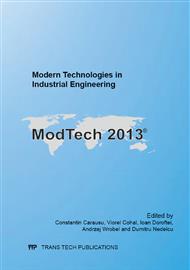p.434
p.440
p.446
p.452
p.458
p.464
p.471
p.477
p.483
Assessment of a Traction Model for Agricultural Tires Based on a Variable Shear Area Model and Experimental Data
Abstract:
The tire driving force is the resultant of the elementary shear forces acting under the running gear contact area; while the tire ground contact area may be assumed to be constant, the sheared area increases with slip but is generally less then the tire-soil contact area. As a result, it may be considered that the tractive force is the result of the elementary forces acting along the portion of the contact area that participates in the shearing process. Starting from this idea, the paper tries to evaluate the shearing area using a traction model and experimental traction data. The traction model and the field tests referred to the driving tires of a 2WD Romanian U-650 tractor; the comparison between experimental data concerning the traction force and the results given by the traction model allowed evaluation of the shear area, using a Komandi type relationship, assuming that shear area is linked to the tire-ground contact area by the means of a wheel slip depending shape parameter D. The goodness-of-fit test applied to the original Komandi equation led to conclusion that this equation was not appropriate for the evaluation of the shear area, at least not for the test conditions. A much better goodness-of-fit between the measured traction forces and the ones predicted by the model was achieved when a modified Komandi type relation was used in order to describe the shape parameter. In this case, 77.8% of the of model predictions were within the 95% confidence interval of each corresponding experimental data point, compared to only 22.2% for the original Komandi equation. In terms of traction efficiency, the modified Komandi equation also led to a better fit between theoretical and experimental data.
Info:
Periodical:
Pages:
458-463
Citation:
Online since:
November 2013
Authors:
Keywords:
Price:
Сopyright:
© 2014 Trans Tech Publications Ltd. All Rights Reserved
Share:
Citation:


